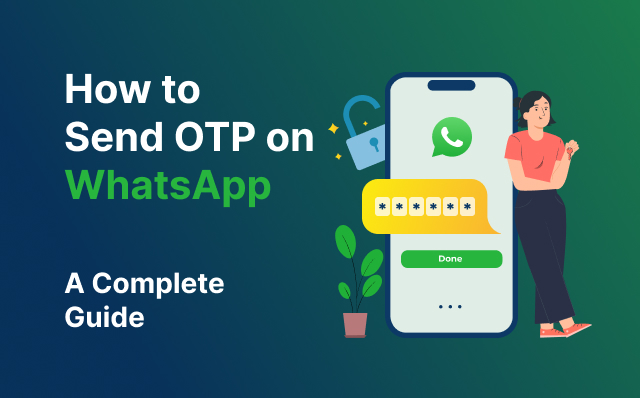Effortlessly send One-Time Passwords (OTP) on WhatsApp with our comprehensive guide. Discover how to send OTP on WhatsApp to enhance your verification process securely.
One-Time Password (OTP) is a short-lived code used for user authentication in applications, providing an extra layer of security for personal information during login and other sensitive activities. The temporary nature of OTPs ensures that data remains secure by being valid only for a brief period.
As a service provider, it is crucial to keep OTP codes confidential. Traditionally, these codes have been sent via SMS, but this method has several security vulnerabilities that can compromise data integrity.
To address these issues, consider switching to the WhatsApp Business API for sending OTP codes. WhatsApp offers end-to-end encryption, higher delivery success rates, and increased user convenience, making it an excellent platform for OTP delivery. In this detailed guide, we will walk you through the steps to send OTPs on WhatsApp, ensuring a secure and efficient process.
Why Send OTP on WhatsApp?
Sending OTPs via WhatsApp offers businesses several advantages, including high delivery rates, enhanced security through encryption, cost-effectiveness, and improved user convenience. These benefits make WhatsApp a preferred platform for businesses looking to ensure secure and efficient OTP delivery to their users.
High Delivery Rates
WhatsApp messages typically have higher delivery rates compared to SMS. Unlike SMS, which can be affected by network issues or delays, WhatsApp messages are sent over the internet and are less likely to be lost or delayed. This reliability ensures that OTPs reach users promptly, enhancing the overall user experience.
Enhanced Security
Messages sent via WhatsApp are end-to-end encrypted, which means that only the sender and the recipient can read the messages. This encryption ensures that OTPs remain secure during transmission, protecting sensitive user information from unauthorized access or interception by third parties. Businesses can reassure users that their OTPs are transmitted securely, contributing to trust and confidence in their services.
Cost-Effectiveness
Sending OTPs through WhatsApp can be more cost-effective for businesses compared to traditional SMS. While SMS charges may vary depending on the carrier and destination, WhatsApp messages are typically charged at a flat rate or included in a subscription plan offered by WhatsApp Business Solution Providers (BSPs). This predictability in cost can help businesses manage their communication expenses more efficiently.
User Convenience
WhatsApp is one of the most widely used messaging platforms globally, with billions of active users. Many users prefer receiving messages, including OTPs, on WhatsApp because it integrates seamlessly into their daily communication habits. Users can receive and view OTPs within the same app they use for personal and business communications, eliminating the need to switch between multiple apps or platforms. This convenience not only enhances user experience but also increases the likelihood of OTPs being promptly accessed and used for authentication purposes
How to Send OTPs Securely Using WhatsApp Business APIs
WhatsApp stands as the world’s most popular communication platform, renowned for its secure and reliable messaging services compared to traditional SMS and related platforms.
Businesses can leverage WhatsApp’s security protocols to send One-Time Passwords (OTPs) effectively. OTPs play a crucial role in verifying logins and transactions, traditionally delivered via SMS. However, SMS-based OTP authentication poses security risks that businesses are increasingly mitigating by adopting WhatsApp’s encrypted OTPs.
WhatsApp’s end-to-end encryption ensures that only the intended recipient can decipher the OTP, enhancing security against spam, malware, and fraud. This encrypted approach is among the most secure methods available today.
Let’s delve deeper into this.
Utilizing WhatsApp Business APIs like Happilee allows businesses to send OTPs securely to WhatsApp users. Introduced in 2018, WhatsApp Business APIs differ from the WhatsApp Business App by enabling small and medium-sized businesses (SMBs) to seamlessly integrate WhatsApp into their operational systems.
Once your company’s WhatsApp business number is approved, integration with your CRM system facilitates automated delivery of OTPs and reminders directly to clients on WhatsApp. This integration streamlines operations and enhances customer engagement through a secure and trusted platform.
Steps to Send OTP on WhatsApp Using WhatsApp Business API
Prerequisites
Before you start sending OTPs on WhatsApp, ensure you have the following:
- A Facebook Business Manager account: This is required to manage your WhatsApp Business account and other Facebook assets.
- A verified WhatsApp Business account: Your business account must be verified to use the WhatsApp Business API.
- An account with a WhatsApp API provider like Happilee: This allows you to access and use the WhatsApp Business API for sending messages.
Step-by-Step Guide
Step 1: Set Up Your WhatsApp Business Account
- Register Your Business: Provide all necessary details and documentation to verify your business. This process includes submitting information such as your business name, address, and contact details.
- Create a WhatsApp Business Profile: Once your business is registered, set up your WhatsApp Business profile by adding your business name, logo, and a brief description. This profile will be visible to your customers and helps in building trust.
- Get Approval: After submitting your details, you will need to wait for approval. Once your business is verified, you will receive approval to use the WhatsApp Business API.
Step 2: Integrate WhatsApp API with Your System
- Obtain API Credentials: Once approved, you will receive API credentials from your API provider. These credentials include the API key, secret, and other necessary details required to authenticate your requests.
- Set Up the API: Use the provided documentation from your API provider to set up the API endpoints for sending messages. This involves configuring your server to communicate with the WhatsApp API securely.
- Develop OTP Generation Logic: Implement a secure mechanism to generate unique, time-sensitive OTPs. Ensure that the OTPs are random and valid only for a short period to enhance security.
- Send OTPs via WhatsApp: With the API set up and OTP generation logic in place, you can start sending OTPs to users’ WhatsApp numbers. Ensure that your message content is clear and instructive, guiding users on how to use the OTP.
Step 3: Secure Your OTP Process
- Use HTTPS: Ensure that all communication with the WhatsApp API is encrypted using HTTPS. This prevents unauthorized access and ensures the security of your data.
- Set Expiry Time: OTPs should be valid for a brief period (e.g., 5 minutes) to minimize the risk of misuse. Implementing a short expiry time enhances security by ensuring that OTPs cannot be reused.
- Limit Attempts: Restrict the number of OTP requests a user can make within a certain timeframe. This helps prevent abuse and potential security threats such as brute-force attacks.
- Audit Logs: Maintain logs of OTP requests and deliveries. These logs are crucial for monitoring and troubleshooting any issues that arise, and they also help in detecting any suspicious activity.
Step 4: Verify OTP
- Prompt User for OTP: After sending the OTP, prompt the user to enter the code they received via WhatsApp. This can be done through your application or website.
- Validate OTP: Compare the entered OTP with the generated code stored on your server. Ensure that the code is correct and within the valid time frame.
- Provide Feedback: Inform the user if the OTP is correct or incorrect. If the OTP is valid, proceed with the authentication process. If the OTP is incorrect, provide clear instructions on how to request a new OTP.
Best Practices for Sending OTPs on WhatsApp
- Clear Instructions: Include clear instructions in your OTP messages on how to use the code. This helps users understand the process and reduces the likelihood of errors.
- Help Contact: Provide a contact method for users who face issues with the OTP. This can be a customer support number or an email address.
- Personalize the Message: Add the user’s name to the OTP message for a personal touch. Personalization helps build trust and ensures the user that the message is intended for them.
- Monitor Delivery: Regularly monitor the delivery status of OTP messages to ensure reliability. This helps in identifying any issues with message delivery and allows you to take corrective actions promptly.
Integrating WhatsApp OTP with Your Application
Step 1: Create a Verification Form
1. Collect Phone Number:
- Create a Form: Design a user-friendly form on your application or website to collect the user’s phone number. Ensure the form includes fields for entering the phone number and any necessary validation to check for correct input formats.
- User Consent: Include a checkbox to obtain user consent for receiving OTPs via WhatsApp. This ensures compliance with privacy regulations.
2. Generate OTP:
- Automatic Generation: Implement a backend system to automatically generate a unique, time-sensitive OTP when the user submits their phone number. Use algorithms to ensure the OTP is random and secure.
- Storing OTP: Store the generated OTP securely in your database with an associated timestamp to track its validity period.
3. Send OTP via WhatsApp:
- API Integration: Use the WhatsApp Business API to send the OTP to the user’s phone number. Configure the API endpoints to send a message containing the OTP along with clear instructions on how to use it.
- Message Content: Craft the message to be clear and concise, such as: “Your verification code is 123456. Please enter this code in the application to verify your phone number.”
Step 2: Implement OTP Verification
1. Prompt for OTP:
- User Interface: After sending the OTP, update the user interface to prompt the user to enter the OTP they received via WhatsApp. Ensure the input field is easily accessible and intuitive to use.
2. Validate OTP:
- Server-Side Validation: When the user enters the OTP, send it to your server to compare it with the stored OTP. Check the entered OTP against the one generated and ensure it is within the valid time frame.
- Security Measures: Implement additional security measures, such as checking the number of attempts and using rate limiting to prevent brute-force attacks.
3. Success or Failure:
- Successful Verification: If the OTP is correct, notify the user of successful verification and proceed to the next step in your application, such as granting access or completing a transaction.
- Failed Verification: If the OTP is incorrect, inform the user and provide an option to request a new OTP. Ensure that error messages are helpful and guide the user on what to do next.
Common Challenges and Solutions
1. Delayed OTP Delivery:
- Check Internet Connectivity: Ensure that the user’s internet connection is stable. Provide guidance on checking their connection if they report issues.
- Retry Mechanism: Implement a system to automatically retry sending the OTP if the initial delivery fails. Set up retries at reasonable intervals to avoid overwhelming the user.
- User Education: Educate users on how to check their WhatsApp notifications and ensure that they have not muted your business number. Provide troubleshooting tips for common issues.
2. Incorrect OTP Entry:
- Limit Attempts: Restrict the number of attempts a user can make to enter the correct OTP. For example, limit to 3-5 attempts before requiring additional verification steps.
- Time-Bound OTPs: Ensure OTPs are valid only for a short period, such as 5 minutes, to enhance security. Inform users about the OTP expiry time to encourage timely entry.
- Clear Instructions: Provide clear and concise instructions on where and how to enter the OTP. Use visual aids and examples if necessary to reduce user errors.
Conclusion
Sending OTPs on WhatsApp can significantly enhance your user authentication process by leveraging the platform’s high engagement rates and secure messaging capabilities. By following the steps and best practices outlined in this guide, you can implement a reliable and efficient OTP delivery system on WhatsApp.
For businesses seeking a robust solution, integrating WhatsApp OTP with your CRM and operational systems through the WhatsApp Business API can streamline processes and improve customer experience. By leveraging WhatsApp’s extensive reach and secure messaging features, businesses can ensure that OTPs are delivered promptly and securely, enhancing user trust and satisfaction.
Happilee, a leading WhatsApp API provider, offers comprehensive solutions to seamlessly integrate OTP delivery into your business operations. With Happilee, you can start leveraging the power of WhatsApp for your OTP delivery today and ensure a secure, cost-effective, and user-friendly authentication process.
Start leveraging the power of WhatsApp for your OTP delivery today and ensure a secure, cost-effective, and user-friendly authentication process.


